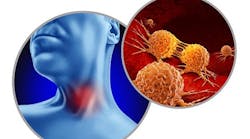It is estimated that 20%–30% of Americans have gastroesophageal reflux disease (GERD).1 GERD is a chronic condition in which the acidic contents of the stomach reflux back up into the esophagus. Unfortunately, while GERD may lead to long-term complications, such as Barrett’s esophagus and esophageal adenocarcinoma, it is often referred to as “acid indigestion” or “heartburn,” which only serves to minimize its significance and consequences if left untreated.
Why should hygienists care about GERD?
So, why do dental hygienists need to understand GERD and its causes? As I have said many times in my presentations over the years, dental hygienists save lives both in their actions and in their words. Our patients may make choices about their own health care that are misinformed and ill-advised due to direct-to-consumer advertising and the widespread availability of over-the-counter (OTC) medications marketed to treat “heartburn.”
Hydrochloric acid: Helping patients understand the risks with taking acid-reducing medications
The dental hygienist's guide to dental pain and pain management
Dental hygienists are sometimes the first health-care professionals to identify the oral manifestations of GERD as symptoms of this underlying disease in patients who may be unaware of its presence. These include eroded dentition, difficulty swallowing, and red or inflamed tissues of the oral cavity and the pharynx.
What you need to know about GERD
Under normal conditions, the esophagus is attached to the stomach at an acute angle. This creates a bend that encourages the one-way passage of food from the esophagus into the stomach, while preventing the reverse flow of stomach contents back into the esophagus. At the junction of the esophagus and the stomach is the lower esophageal sphincter (LES). This ring of muscle contracts and, assisted by contractions of the diaphragm, further prevents the backflow of stomach contents into the esophagus.2
As its name suggests, GERD is a condition in which stomach contents regurgitate, or “reflux,” into the lower esophagus. In patients suffering from GERD, the LES does not maintain sufficient tone and relaxes inappropriately several times per day. This allows the acidic contents of the stomach to backflow, or reflux, into the esophagus and erode the esophageal tissues.2 The acidic stomach contents have the potential to reflux even higher into the esophagus. Once there, they may be aspirated into the lungs, causing respiratory problems, and the oral cavity, resulting in soft-tissue irritation and tooth erosion.2
Many patients with GERD are also diagnosed with hiatal hernia.3 This occurs when a portion of the upper stomach protrudes, or herniates, through the esophageal hiatus (the hole in the diaphragm through which the esophagus passes) into the chest cavity above the diaphragm. In this position, the diaphragm can no longer assist the LES in preventing stomach contents from refluxing into the lower esophagus. In addition, in this position, the angle at which the esophagus enters the stomach is decreased, increasing the possibility of reflux.3
Symptoms of GERD
While many people have GERD, it may occur with little or no symptoms, or with atypical symptoms, such as cough, wheezing, laryngitis, chest pain, sour taste, difficulty swallowing, and halitosis.3 Clinical diagnosis is most often accomplished with upper gastrointestinal (GI) radiographs and esophageal endoscopy.
Treatment options and medication interaction
Treatment of GERD focuses on controlling symptoms, healing any existing esophageal irritation, and preventing future recurrence of the disease. Nonpharmacological treatment of GERD requires lifestyle changes and behavior modifications, including the avoidance of certain foods (such as alcohol, caffeine, spicy foods, and high-fat foods), eating smaller and more frequent meals no later than three to four hours prior to bedtime, smoking cessation, and weight loss.
Pharmacological treatment of GERD includes the use of histamine-2 receptor antagonists, proton pump inhibitors, and antacids.4 Histamine-2 receptor antagonists partially inhibit gastric acid secretion by competitively inhibiting the action of histamine at its receptors on the parietal cells. Cimetidine (Tagamet), famotidine (Pepcid), and ranitidine (Zantac) are frequently used histamine-2 receptor antagonists. Adverse reactions of these drugs include central nervous system effects (such as confusion and headache) and oral manifestations (such as xerostomia, taste alterations, and halitosis).4,5
Proton pump inhibitors (PPIs), such as omeprazole (Prilosec) and esomeprazole (Nexium), are widely used to treat GERD. PPIs inhibit gastric acid secretion by disabling the “proton pump” within parietal cells, inhibiting the secretion of acid. These medications have few side effects, other than headache and abdominal pain. Oral manifestations of these agents include xerostomia and mucosal atrophy of the tongue.4-6
Both histamine-2 receptor antagonists and PPIs may alter the hepatic metabolism of many drugs, resulting in drug interactions that may be significant. The use of PPIs may also result in gastric pH high enough to interfere with the absorption and efficacy of certain drugs, vitamins (such as B6 and B12), and minerals (such as calcium).4-6
Antacids are effective since they neutralize stomach acid that is already present. However, they may cause rebound hyperacidity as well as hypercalcemia, constipation, and diarrhea. Antacids may bind to some drugs and reduce their overall efficacy. They may also alter urinary pH and interfere with the renal excretion of some drugs.
Dental hygiene considerations
Patients with GERD will require some dental hygiene treatment modifications. Medications used in dentistry that cause GI side effects (such as NSAIDs) should be avoided in favor of medications that don’t cause these effects (such as acetaminophen). Proper patient positioning in the dental chair (in a semisupine position) may increase patient comfort. The use of fluoride to protect against erosive challenges to the dentition may be necessary.
Many patients regularly self-medicate to treat their symptoms of GERD. The abundance of OTC acid-reducing drugs (many of which were previously available only by prescription) reflects the prevailing attitude that “heartburn” is little more than an inconvenience and merely a warning to “watch what you eat.” Although most patients with GERD may be unaware of the condition, they should be referred to medical practitioners for appropriate medical care. Dental hygienists who are knowledgeable about the pathological mechanisms and treatment of GERD are crucial to providing information necessary for the safe and proper care of their patients.
Editor's note: This article appeared in the December 2022 print edition of RDH magazine. Dental hygienists in North America are eligible for a complimentary print subscription. Sign up here.References
- El-Serag HB, Sweet S, Winchester CC, Dent J. Update on the epidemiology of gastro-oesophageal reflux disease: a systematic review. Gut. 2014;63(6):871-880. doi:10.1136/gutjnl-2012-304269
- Gastroesophageal reflux disease (GERD). Mayo Clinic. Accessed October 1, 2022. https://www.mayoclinic.org/diseases-conditions/gerd/symptoms-causes/syc-20361940
- Ranjitkar S, Kaidonis JA, Smales RJ. Gastroesophageal reflux disease and tooth erosion. Int J Dent. 2012;2012:479850. doi:10.1155/2012/479850
- van Pinxteren B, Sigterman KE, Bonis P, Lau J, Numans ME. Short-term treatment with proton pump inhibitors, H2-receptor antagonists and prokinetics for gastro-oesophageal reflux disease-like symptoms and endoscopy negative reflux disease. Cochrane Database Syst Rev. 2010;(11):CD002095. doi:10.1002/14651858.CD002095.pub4
- Khan M, Santana J, Donnellan C, Preston C, Moayyedi P. Medical treatments in the short term management of reflux oesophagitis. Cochrane Database Syst Rev. 2007;(2):CD003244. doi:10.1002/14651858.CD003244.pub2
- Wang YK, Hsu WH, Wang SSW, et al. Current pharmacological management of gastroesophageal reflux disease. Gastroenterol Res Pract. 2013;2013:983653. doi:10.1155/2013/983653






